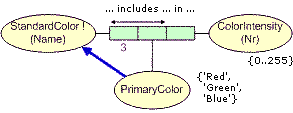Verbalizing Business Rules (Part 10)
Business rules should be validated by business domain experts, and hence specified using concepts and languages easily understood by business people. This is the tenth in a series of articles on expressing business rules formally in a high-level, textual language. This article deals with verbalization of internal frequency constraints on single roles.
The first article[3] discussed criteria for a business rules language, and verbalization of simple uniqueness and mandatory constraints on binary associations. Article two[4] examined hyphen-binding, and verbalization of internal uniqueness constraints that span a whole association, or that apply to n-ary associations. Article three[5] covered verbalization of basic external uniqueness constraints. Article four[6] considered relational-style verbalization of external uniqueness constraints involving nesting or long join paths, as well as attribute-style verbalization of uniqueness constraints and simple mandatory constraints.
Article five[7] discussed verbalization of mandatory constraints on roles of n-ary associations, and disjunctive mandatory constraints (also known as inclusive-or constraints) over sets of roles. Article six[8] considered verbalization of value constraints. Article seven[9] examined verbalization of subset constraints. Article eight[10] discussed verbalization of equality constraints. Article nine[11] covered verbalization of exclusion constraints.
Consider the output report displayed in Table 1, which lists details about musical duets -- i.e., pairs of musicians who perform together. The Everly Brothers is an actual duet, but the other duet examples are invented for discussion purposes. In this business domain, musicians are identified simply by their name, so the Don Everly appearing in two duets is the same person. The third column indicates whether or not the duet is currently popular. Assume closed world semantics for popularity -- i.e., for each duet we do know its popularity. The '?' mark indicates missing information -- we know the name and popularity of the Northface Duo, but its members are not yet decided. For each duet in this business domain, our knowledge about its membership is either complete (we know both the members) or totally incomplete (we know neither member). In other words, we cannot know that one person is a member of a duet without knowing who the other duet member is.
Table 1. Details about some musical duets. Duet
Musicians
Popular?
Everly Brothers
Don Everly, Phil Everly
Yes
Two Dons
Don Everly, Donovan Leitch
Yes
Northface Duo
?
No
Figure 1 shows one way to schematize this report in Object-Role Modeling (ORM).
A duet's popularity is modeled using the unary fact type Duet
is popular. A duet's membership is modeled using the binary fact
type Duet includes Musician (inverse
reading: Musician is a member of Duet).
The arrow-tipped bar on the binary fact type denotes a spanning uniqueness constraint,
indicating that the relationship is many-to-many (the same duet may include more
than one musician, and the same musician may be a member of more than one duet),
and that each membership fact is recorded just once (for each state of the business).
The '2' beside Duet's role in the membership fact type indicates the frequency (number
of occurrences) for that role, for each duet that plays that role. In ORM this
is called a frequency constraint. Verbalizing this kind of constraint
is the focus of this article.

Figure 1. An ORM schema for Table 1.
Adding a frequency constraint of 2 to Duet's role in the membership predicate means that, for each state of the business domain, each duet that plays that role does so 2 times. This constraint is perhaps best understood by populating the schema with the fact instances from the original report, as shown in Figure 2. In ORM, an object type's instances may be displayed in a table, and an elementary fact type's instances may be displayed in a table, with a column for each role.
The table beneath the Duet entity type lists three duets, which is equivalent to stating three existential facts:
there is a Duet that has DuetName 'Everly Brothers';
there is a Duet that has DuetName 'Two Dons';
there its a Duet that has DuetName 'Northface Duo'.
The table below the unary fact type lists two elementary facts:
Duet 'Everly Brothers' is popular;
Duet 'Two Dons' is popular.
Given the closed world assumption, the absence of Northface Duo in this table indicates the negated fact that Northface Duo is not popular. The table below the binary fact type lists four elementary facts:
Duet 'Everly Brothers' includes Musician 'Don Everly';
Duet 'Everly Brothers' includes Musician 'Phil Everly';
Duet 'Two Dons' includes Musician 'Don Everly';
Duet 'Two Dons' includes Musician 'Donovan Leitch'.

Figure 2. Populating the previous ORM schema with fact instances.
Notice that each entry in the fact column for Duet's role in the membership fact type occurs there exactly twice, in accordance with the frequency constraint of 2 on that role. This frequency constraint may be formally verbalized in relational style in either of the following ways:
Each Duet includes zero or two instances of Musician.
Each Duet that includes a Musician includes two instances of Musician.
If automated support for pluralization is available, more natural readings are obtained by replacing "instances of Musician" by "Musicians" in the above verbalizations. In this series of articles, we do not assume that such support is available.
The first verbalization above is especially appropriate if the schema is presented
in UML notation, as shown in Figure 3(b). In UML, the frequency constraint
appears as a compound multiplicity constraint '0, 2' (zero or two) next to the role
played by Musician. The '{P}' annotation is a non-standard extension to UML
to express the preferred identifier (and hence its uniqueness constraint).
UML does not directly support unary fact types, so popularity is modeled as the Boolean
attribute ' isPopular '.
For binary associations, the relevant UML multiplicity constraint applies to the
role opposite the role with the ORM frequency constraint.

Figure 3. (a) The previous ORM schema, and (b) an equivalent UML class diagram.
As an extension to UML, the class diagram could be populated by a fact table for the binary association, but UML's use of attributes makes it less convenient to populate the rest of the diagram (instead of single fact tables, UML uses multiple object diagrams for such purposes). So we do not bother displaying the fact population in UML.
A frequency constraint depicted in ORM by a positive integer corresponds to an 'all-or-nothing' case of knowledge completeness. More commonly, frequency constraints simply set just an upper or lower bound on knowledge completeness. For example, suppose we modify our example so that for each duet we may know zero, one, or both of the musicians in the duet. An illustrative population is shown in Table 2.
|
Duet |
Musicians |
Popular? |
|
Everly Brothers |
Don Everly, Phil Everly |
Yes |
|
Two Dons |
Don Everly, Donovan Leitch |
Yes |
|
Northface Duo |
? |
No |
|
Minnesota Twins |
Pat Barden |
No |
ORM and UML schemas for this situation are shown in
Figure 6 . The ORM frequency constraint is now depicted by placing '![]() 2' (less than or equal to 2) next
to the relevant role. If you populate this role with the sample membership
data, you'll notice that each duet in the role's fact column appears there at most
twice. In UML, the corresponding multiplicity constraint becomes '0..2'.
This frequency constraint may be verbalized thus:
2' (less than or equal to 2) next
to the relevant role. If you populate this role with the sample membership
data, you'll notice that each duet in the role's fact column appears there at most
twice. In UML, the corresponding multiplicity constraint becomes '0..2'.
This frequency constraint may be verbalized thus:
Each Duet includes at most two instances of Musician.

Figure 4. Modeling the structure of Table 2 in (a) ORM and (b) UML
Now let's modify our example, requiring that we know who all the members are of each duet. Table 3 illustrates this situation, listing two Northface Duo musicians.
|
Duet |
Musicians |
Popular? |
|
Everly Brothers |
Don Everly, Phil Everly |
Yes |
|
Two Dons |
Don Everly, Donovan Leitch |
Yes |
|
Northface Duo |
Shania Triad, Suzi Quinquo |
No |
Figure 5 models the structure of Table 3 in ORM and UML. From an ORM perspective, the frequency constraint of 2 on Duet's role in the membership fact type is unchanged from the original case for Table 1. However, a mandatory constraint has been added to that role (depicted by a solid dot on its role connector) to indicate that each instance of Duet's population must play that role. For each state of the business, the term 'population' denotes the set of known instances for that state (typically a subset of the type, which includes the instances from all possible states). In UML, the multiplicity constraint becomes '2' (or 2..2).

Figure 5. Modeling the structure of Table 3 in (a) ORM and (b) UML.
The frequency and mandatory constraints may be verbalized separately, for example:
Each Duet includes zero or two instances of Musician.-- frequency constraint
Each Duet includes at least one Musician.-- mandatory constraint
Alternatively, the combination of both constraints may be verbalized more compactly thus:
Each Duet includes exactly two instances of Musician.-- frequency and mandatory
constraints combined
An ORM frequency constraint may be considered to be a generalization of an ORM uniqueness constraint. Basically, a uniqueness constraint is a frequency constraint where the frequency equals one, but uniqueness is such an important case that it deserves a special treatment and notation of its own, as discussed in earlier articles.
Like uniqueness constraints, frequency constraints in ORM are local to their predicate, in contrast to mandatory role constraints, which have global impact by implying subset constraints involving other roles played by the same object type. This separation of local and global aspects enhances ORM's orthogonality, minimizing the impact of changes to existing constraints. In contrast, UML collapses the two constraints into a single multiplicity constraint, thereby reducing orthogonality. As discussed in the next article, UML's multiplicity constraint is also incapable of specifying certain kinds of ORM frequency constraint when the fact type or association is n-ary (3 roles or more).
Frequency constraints may also specify lower bounds on frequencies,
using the notation '![]() n ' for 'at least n', or frequency ranges using the notation 'n..
m' for 'at least n and at most m'. Figure 6 shows some
examples in ORM, based on an example from [1, p. 281]. The
exclamation mark in 'Panel !' indicates the independence of this object type -- i.e.,
we may know a given instance independently of knowing any other facts about it.
The '4..7', '
n ' for 'at least n', or frequency ranges using the notation 'n..
m' for 'at least n and at most m'. Figure 6 shows some
examples in ORM, based on an example from [1, p. 281]. The
exclamation mark in 'Panel !' indicates the independence of this object type -- i.e.,
we may know a given instance independently of knowing any other facts about it.
The '4..7', '![]() 5', and '
5', and '![]() 2'
respectively denote a frequency range constraint, a maximum frequency constraint,
and a minimum frequency constraint.
2'
respectively denote a frequency range constraint, a maximum frequency constraint,
and a minimum frequency constraint.

Figure 6. Examples of constraints on frequency minima, maxima, and ranges.
A UML class diagram for the same example is shown in Figure 7. Role names have been added to clarify the semantics. As usual, UML uses multiplicity constraints to capture both mandatory and frequency constraints. This works fine for binary associations, but leads to some problems with n-ary associations, as discussed in the next article.

Figure 7. A UML class diagram corresponding to the ORM schema in Figure 10.
The three frequency constraints may be verbalized as follows:
Each Panel that includes an Expert includes at least 4 and at most 7 instances of Expert.
Each Expert reviews at most 5 instances of Paper.
Each Paper that is reviewed by an Expert is reviewed by at least two instances of Expert.
Alternative verbalizations exist -- e.g., the third constraint may be recast as:
Each Paper is reviewed by either zero instances,
or at least two instances, of Expert. Again, a pluralization
engine would enable more natural verbalizations. Though very rare in practice,
disjunctions of frequency specifications may be specified using a comma-delimited
list -- e.g., '3, 5..7, ![]() 10' for '3, or between 5 and 7 inclusive, or at least 10'.
10' for '3, or between 5 and 7 inclusive, or at least 10'.
Single role frequency constraints may also apply to n -ary predicates.
As a ternary example, consider the report in Table 4 . The first column lists
the standard colors (unlike custom colors, standard colors are always given unique
names). The standard colors Red
Green , and Blue
are primary in the sense that the other colors may be formed by combining the primary
colors in different ratios. For example, Plum
is composed of 153 parts of Red
(out of maximum possible 255), 51 parts of Green
, and 102 parts of Blue.
In this table, the nulls indicate that the composition of the Autumn
color is unknown.
|
Standard Color |
Primary Color |
Color Intensity |
|
Plum |
Red |
153 |
|
Plum |
Green |
51 |
|
Plum |
Blue |
102 |
|
Red |
Red |
255 |
|
Red |
Green |
0 |
|
Red |
Blue |
0 |
|
Autumn |
? |
? |
Figure 8 shows one way to model this structure in ORM. The frequency constraint of 3 on the first role of the ternary may be verbalized as shown below.
Each StandardColor that includes a PrimaryColor in a ColorIntensity plays that role 3 times.
As usual, the existential quantifier verbalized here as ' a'
may be reworded as ' some' or
'at least one'. Here 'plays that role' is read in the normal
way -- i.e., in the least restrictive sense. In other words, for each of the
three occurrences of any given StandardColor
that plays the role, it is possible that the associated instances of PrimaryColor in the fact table may differ, and
likewise for the associated instances of ColorIntensity
.

Figure 8. An ORM schema for Table 4.
Although the above situation may be modeled with a ternary association in UML
using classes for StandardColor
, PrimaryColor , and ColorIntensity, it would be more usual in UML
to treat ColorIntensity as an
attribute of an association class representing an inclusion association between StandardColor and PrimaryColor.
The next article will include examples of frequency constraints over associations
that would typically be modeled as n-aries in UML.
That completes our coverage of internal frequency constraints on single roles and their verbalization. The next article considers verbalization of more complex frequency constraints: multi-role frequency constraints (applying to sequences of two or more roles); and external frequency constraints (involving more than one predicate).
References
[1] T.A. Halpin. Information Modeling and Relational
Databases. Morgan Kaufmann, San Francisco, 2001. ![]()
[2] T.A. Halpin. "Metaschemas for ER, ORM and UML Data Models: A Comparison," Journal of Database Management, Vol. 13, No. 2 (2002), pp. 20-29. Idea Publishing Group, Hershey, PA, USA.
[3] T.A. Halpin. "Verbalizing Business Rules
(part 1)," Business Rules Journal, Vol. 4, No. 4 (April 2003).
URL: http://www.BRCommunity.com/a2003/b138.html ![]()
[4] T.A. Halpin. "Verbalizing Business Rules
(part 2)," Business Rules Journal, Vol. 4, No. 6 (June 2003). URL: http://www.BRCommunity.com/a2003/b152.html ![]()
[5] T.A. Halpin. "Verbalizing Business Rules
(part 3)," Business Rules Journal, Vol. 4, No. 8 (August 2003).
URL: http://www.BRCommunity.com/a2003/b163.html ![]()
[6] T.A. Halpin. "Verbalizing Business Rules
(part 4)," Business Rules Journal, Vol. 4, No. 10 (October 2003).
URL: http://www.BRCommunity.com/a2003/b172.html ![]()
[7] T.A. Halpin. "Verbalizing Business Rules
(part 5)," Business Rules Journal, Vol. 5, No. 2 (February 2004).
URL: http://www.BRCommunity.com/a2004/b179.html ![]()
[8] T.A. Halpin. "Verbalizing Business Rules
(part 6)," Business Rules Journal, Vol. 5, No. 4 (April 2004).
URL: http://www.BRCommunity.com/a2004/b183.html ![]()
[9] T.A. Halpin. "Verbalizing Business Rules
(part 7)," Business Rules Journal, Vol. 5, No. 7 (July 2004). URL: http://www.BRCommunity.com/a2004/b198.html ![]()
[10] T.A. Halpin. "Verbalizing Business Rules
(part 8)," Business Rules Journal, Vol. 5, No. 9 (September 2004).
URL: http://www.BRCommunity.com/a2004/b205.html ![]()
[11] T.A. Halpin. "Verbalizing Business Rules
(part 9)," Business Rules Journal, Vol. 5, No. 12 (December 2004).
URL: http://www.BRCommunity.com/a2004/b215.html ![]()
[12] T.A. Halpin, K. Evans, P. Hallock, & B. MacLean. Database Modeling with Microsoft Visio for Enterprise Architects. Morgan Kaufmann, San Francisco, 2003.
[13] Object Management Group. UML 2.0 Infrastructure. Object Management Group, 2003. URL: http://www.omg.org/uml
[14] Object Management Group. UML 2.0 Object Constraint Language. Object Management Group, 2003. URL: http://www.omg.org/uml
# # #
About our Contributor:
Online Interactive Training Series
In response to a great many requests, Business Rule Solutions now offers at-a-distance learning options. No travel, no backlogs, no hassles. Same great instructors, but with schedules, content and pricing designed to meet the special needs of busy professionals.












How to Define Business Terms in Plain English: A Primer
How to Use DecisionSpeak™ and Question Charts (Q-Charts™)
Decision Tables - A Primer: How to Use TableSpeak™
Tabulation of Lists in RuleSpeak®: A Primer - Using "The Following" Clause
Business Agility Manifesto
Business Rules Manifesto
Business Motivation Model
Decision Vocabulary
[Download]
[Download]
Semantics of Business Vocabulary and Business Rules